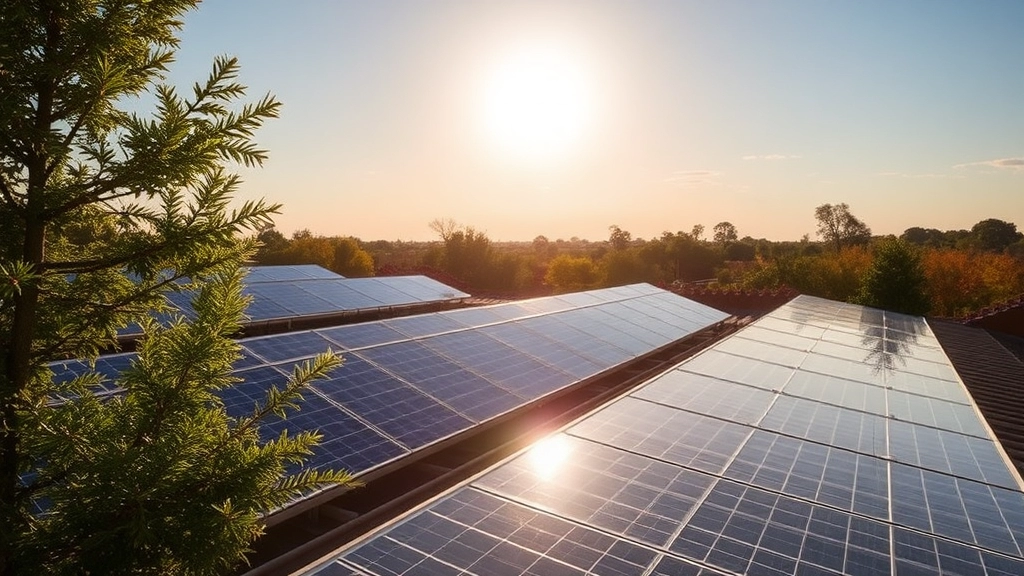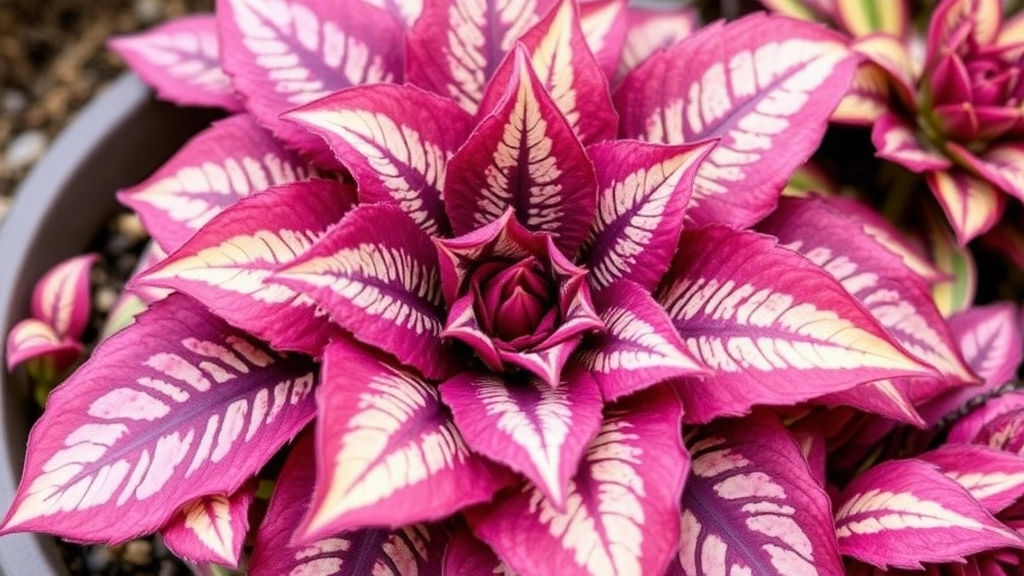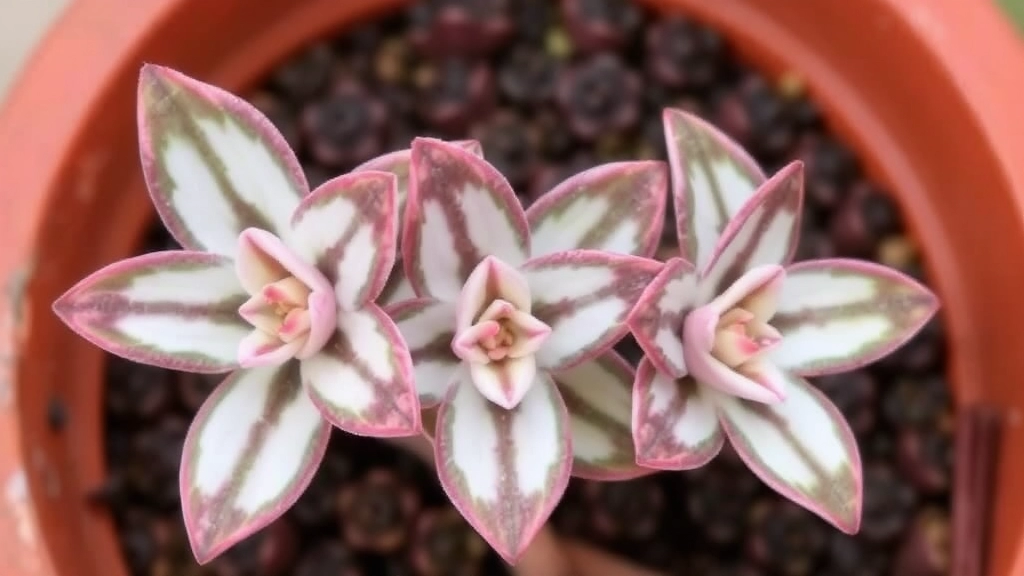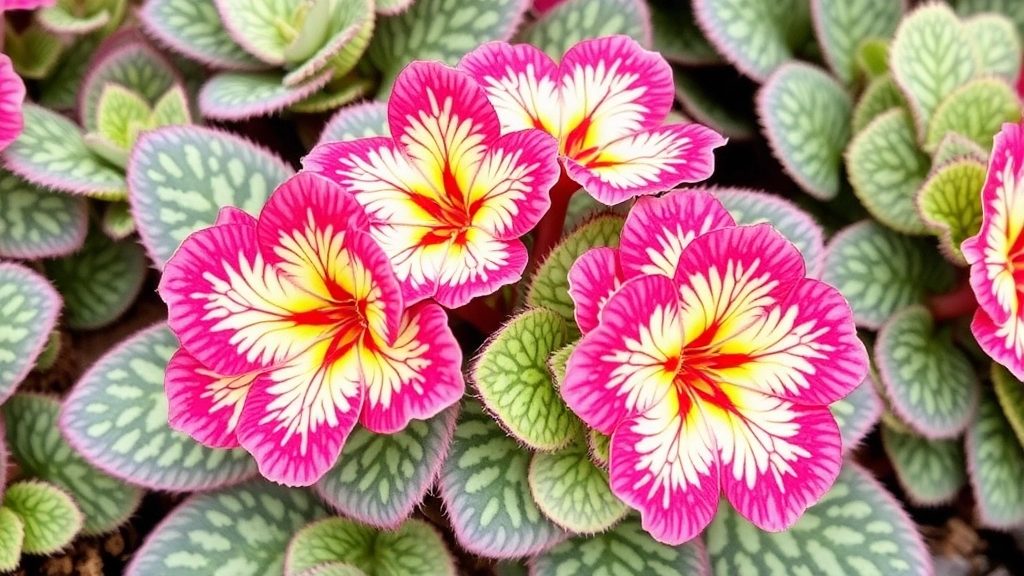Kalanchoe Flapjack Variegated Care Guide
If you’re fascinated by the unique beauty of the Kalanchoe Flapjack Variegated, you’re in the right place. This succulent stands out with its striking, variegated leaves and vibrant colours, making it a favourite among plant enthusiasts. In this guide, I’ll share essential tips on how to care for this plant, ensuring it thrives and retains its captivating appearance.
From understanding its optimal sunlight and temperature conditions to mastering the art of watering and soil selection, I’ll cover everything you need to know. Whether you’re looking to enhance your indoor garden or create a stunning outdoor arrangement, the Kalanchoe Flapjack Variegated is a versatile and eye-catching choice. Let’s dive into the specifics of maintaining its variegated beauty and explore the best practices for propagation and pairing with other succulents.
Key Characteristics of Variegated Kalanchoe Flapjack
When considering the Variegated Kalanchoe Flapjack, you may be wondering what makes this succulent stand out.
This plant is not just visually striking; it has several key characteristics that make it a favourite among succulent enthusiasts.
Optimal Sunlight and Temperature Conditions

So, you’ve got your Variegated Kalanchoe Flapjack and you’re wondering how to keep it thriving, right? One of the biggest factors in its success is getting the sunlight and temperature just right.
Sunlight Needs
This beauty loves the sun, but it’s a bit picky about how much it gets.
- Bright, Indirect Light: Aim for around 6 hours of bright, indirect sunlight daily.
- Avoid Harsh Afternoon Sun: Direct sunlight can scorch those lovely leaves, so consider a spot where it can soak up the morning sun instead.
- Signs of Too Little Light: If the leaves start stretching or losing their vibrant colour, it’s a sign it’s not getting enough light.
Temperature Preferences
Temperature plays a crucial role too.
- Ideal Range: Keep it between 20°C to 25°C (68°F to 77°F) during the day.
- Nighttime Chill: It can tolerate cooler nights, but try not to drop below 10°C (50°F).
- Avoid Sudden Changes: This plant isn’t a fan of drastic temperature swings, so keep it in a stable environment.
By ensuring your Variegated Kalanchoe Flapjack gets the right amount of sunlight and stays in a comfy temperature zone, you set the stage for vibrant growth and stunning leaves.
Watering and Soil Requirements for Healthy Growth
When it comes to caring for your Variegated Kalanchoe Flapjack, understanding its watering and soil needs is crucial for promoting vibrant health and stunning coloration.
Watering Guidelines
Many plant enthusiasts often worry about overwatering their succulents, and rightly so. For Variegated Kalanchoe Flapjack, it’s essential to adopt a careful approach:
- Frequency: Water only when the top inch of soil feels dry. This typically means watering every 2-3 weeks during the growing season (spring and summer).
- Technique: Ensure you water thoroughly, allowing excess to drain out of the pot. Avoid letting the plant sit in water, as this can lead to root rot.
- Signs of Need: Look for drooping leaves or a shriveled appearance, which indicate that your plant is thirsty.
Soil Requirements
The right soil is equally important for the health of your Variegated Kalanchoe Flapjack:
- Type: Use a well-draining cactus or succulent mix. This type of soil prevents water retention, which is vital for these plants.
- pH Level: Aim for a slightly acidic to neutral pH, around 6.0 to 7.0, to support optimal growth.
- Additives: Consider mixing in perlite or coarse sand to enhance drainage further.
By adhering to these watering and soil guidelines, you can ensure your Variegated Kalanchoe Flapjack thrives and maintains its beautiful variegated leaves. For more detailed advice, check out our Ultimate Guide to Fuzzy Kalanchoe Care Tips and learn how to Propagate Kalanchoe from Leaves Successfully.
Managing the Variegated Coloration

One of the most striking features of the Variegated Kalanchoe Flapjack is its unique and vibrant coloration. However, maintaining this variegation can be a concern for many plant enthusiasts.
Why Does Variegation Matter?
Variegation not only adds visual interest but also indicates the plant’s health. Here are some common worries:
- Loss of Colour: You may notice that the bright colours begin to fade.
- Uniform Green Growth: Sometimes, the plant may revert to a solid green.
How to Maintain Variegated Colouration
To keep your Kalanchoe looking its best, consider the following tips:
- Optimal Sunlight: Ensure your plant receives bright, indirect sunlight. Too little light can lead to a loss of variegation.
- Temperature Control: Maintain a warm environment. Extreme cold can stress the plant, leading to green growth.
- Balanced Fertilisation: Use a diluted, balanced fertiliser during the growing season. This promotes healthy growth and enhances colour.
Monitor Your Plant
Regularly check your plant for signs of stress or fading colour. If you notice any changes, it may be time to adjust your care routine.
Common Issues and Solutions in Growing Variegated Kalanchoe
Growing Variegated Kalanchoe Flapjack can be an enjoyable experience, but it does come with its challenges. Many budding gardeners often ask: “Why are my leaves turning brown?” or “How can I maintain that beautiful variegation?”
1. Leaf Discoloration
Problem: Leaves turning brown or dropping can be alarming.
Solution:
- Overwatering: Ensure the soil is well-draining. Allow the top inch of soil to dry out before watering again.
- Underwatering: Conversely, if the leaves feel shrivelled, increase your watering frequency.
- Sunburn: If the plant is exposed to direct, harsh sunlight, consider relocating it to a spot with filtered light.
2. Loss of Variegation
Problem: You may notice the vibrant colours fading.
Solution:
- Insufficient Light: Variegated Kalanchoe requires bright, indirect sunlight to maintain its colour. If it’s not getting enough light, it may revert to solid green.
- Rotate Your Plant: Regularly turning your plant can ensure even light distribution, promoting consistent variegation.
3. Pest Infestations
Problem: Pests like mealybugs or aphids can invade your plant.
Solution:
- Regular Inspections: Check the undersides of leaves and around the stems.
- Natural Remedies: Use neem oil or insecticidal soap to treat infestations. Wipe the leaves with a damp cloth to remove any pests.
4. Root Rot
Problem: This can occur if the plant is overwatered or the soil is not well-draining.
Solution:
- Check Drainage: Ensure your pot has drainage holes and use a gritty, well-draining soil mix.
- Repot if Necessary: If root rot is detected, remove the plant from its pot, trim away damaged roots, and repot in fresh soil.
5. Temperature Stress
Problem: Extreme temperatures can cause stress.
Solution:
Propagation Techniques for Variegated Kalanchoe

So, you’re keen on multiplying your Variegated Kalanchoe Flapjack? Great choice! Propagating this succulent can be a rewarding experience, and it’s easier than you might think.
Why Propagate?
You might be wondering why bother with propagation. Well, it’s a fantastic way to expand your plant collection or share with friends. Plus, it’s a fun project that can bring a little joy to your day.
Propagation Methods:
- Leaf Cuttings:
- Choose a healthy leaf from the parent plant.
- Use a clean, sharp knife to cut it off.
- Let the cut end dry for a few hours or overnight. This helps prevent rot.
- Place the leaf on well-draining soil, ensuring the cut end touches the soil.
- Water lightly and keep it in bright, indirect light.
- Offsets:
- Check for small offsets at the base of the plant.
- Gently twist or cut them away from the main plant.
- Allow them to dry for a day or two.
- Plant them in their own pots with the right soil mix.
- Stem Cuttings:
- Cut a healthy stem from the plant.
- Remove the lower leaves and let the cut end dry.
- Place it in soil, keeping it upright.
- Water sparingly and provide indirect sunlight.
Tips for Successful Propagation:
- Patience is Key: It may take a few weeks for roots to develop.
- Humidity Helps: A plastic bag over the pot can create a mini greenhouse effect.
- Watch for Signs: If you see new leaves sprouting, you’re on the right track!
Remember, the goal is to create a thriving new plant. As you get the hang of it, you might even find yourself experimenting with different methods.
Ideal Potting and Placement for Indoor Growth
When it comes to ensuring the health of your Variegated Kalanchoe Flapjack, choosing the right pot and placement is crucial. You might wonder, “What type of pot should I use?” or “Where should I place my plant for optimal growth?”
Pairing Kalanchoe Flapjack with Other Succulents in Arrangements
So, you’ve got your stunning Variegated Kalanchoe Flapjack, and now you’re wondering how to jazz it up with other plants, right?
Pairing succulents can really elevate your space. The trick is to choose companions that not only complement the Kalanchoe’s vibrant colours but also share similar care requirements.
Here’s what I’ve learned about creating that perfect succulent arrangement:
- Consider Colour Harmony:
- Look for plants with contrasting or complementary colours.
- For instance, the deep greens of Echeveria or the soft blues of Sedum can really make the Kalanchoe pop.
- Texture Matters:
- Mix different textures for visual interest.
- Think about the smooth leaves of Aloe Vera alongside the fleshy, rounded leaves of your Kalanchoe.
- Size and Shape:
- Choose plants that vary in height.
- Taller plants like Agave can add drama, while smaller ones like Haworthia can fill in the gaps.
- Similar Care Needs:
- Make sure all your succulents thrive in similar conditions.
- The Kalanchoe loves bright light and well-draining soil, so partners should too!
- Create Layers:
- Arrange taller plants at the back and shorter ones in front.
- This creates depth and makes your display more eye-catching.
- Add Some Ground Cover:
- Consider using low-growing succulents like Moss Rose as a ground cover to fill in the base of your arrangement.
- Experiment with Containers:
- Use unique pots or containers that match your home decor.
- Terracotta pots or ceramic bowls can really enhance the overall look.
When you pair your Kalanchoe Flapjack with the right succulents, it can turn into a stunning focal point in your home. For more tips on how to care for your Kalanchoe, check out our Kalanchoe Flapjack Paddle Plant Care Guide and learn about other easy propagation methods for Variegated Kalanchoe.
FAQs about Variegated Kalanchoe Flapjack
What are the optimal sunlight conditions for a Variegated Kalanchoe Flapjack?
The Variegated Kalanchoe Flapjack thrives in bright, indirect sunlight. Aim for about 6 hours of such light daily. Avoid exposing it to harsh afternoon sun, as direct sunlight can scorch its leaves.
How can I tell if my plant is not getting enough light?
If your Variegated Kalanchoe Flapjack’s leaves start stretching or losing their vibrant colour, it’s a sign that the plant is not receiving enough light.
What is the ideal temperature range for this plant?
The ideal daytime temperature for a Variegated Kalanchoe Flapjack is between 20°C to 25°C (68°F to 77°F). At night, it can tolerate cooler temperatures but try not to let it drop below 10°C (50°F).
Why is variegation important for my Kalanchoe Flapjack?
Variegation adds visual interest and indicates the plant’s health. A loss of variegation can signify stress or improper care.
How can I maintain the variegated coloration of my plant?
Ensure your plant receives optimal sunlight, maintain a warm environment, and use a balanced, diluted fertilizer during the growing season. These steps will help maintain its vibrant colors.
What are the signs of stress in my Variegated Kalanchoe Flapjack?
Signs of stress include fading color, uniform green growth, or changes in leaf texture. Regularly monitor your plant and adjust your care routine if you notice any of these signs.
What are the methods for propagating a Variegated Kalanchoe Flapjack?
You can propagate your plant through leaf cuttings, offsets, or stem cuttings. Each method involves specific steps to ensure successful growth.
How do I propagate using leaf cuttings?
Choose a healthy leaf, cut it off with a clean, sharp knife, let the cut end dry, then place it on well-draining soil. Water lightly and provide bright, indirect light.
Can I propagate using offsets?
Yes, you can. Look for small offsets at the base of the plant, gently twist or cut them away, let them dry for a day or two, and then plant them in their own pots with the right soil mix.
What are some tips for successful propagation?
Be patient as it may take a few weeks for roots to develop. Creating a mini greenhouse effect with a plastic bag can help, and watch for new leaves sprouting as a sign of success.
Why should I propagate my Variegated Kalanchoe Flapjack?
Propagation is a fantastic way to expand your plant collection, share with friends, and enjoy a rewarding gardening project.
References
-
Kalanchoe Plant Care – Gardening Know How
-
How to Grow Kalanchoe Indoors – The Spruce
-
Kalanchoe Thyrsiflora – House Plants Expert
